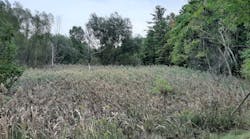Digging With the Best
Contractor J&J Crisafulli has seeded tens of thousands of acres in Montana, where most of the terrain is quite the opposite from the lake country of New York. Many of the sites are along railroads, in cuttings where the slopes are as steep as mountains (because that’s what they are). “Before placing the seed and mulch on slopes, we make sure those slopes are in the right condition to accept them,” states Joey Crisafulli. “We have found tracked dozers good for going up and down slopes, but some of these new machines that can automatically adjust their balance seem to work well by going along the slopes. They seem to eliminate that fear of toppling over. Stability is essential for any work on slopes from the standpoint of the operator’s safety and the efficiency of the work.”
“Ride control” is what Case calls its antipitching system on the XT Series skid-steer loaders. It reduces the pitching caused by the motions of the machine when loading material and when driving on irregular surfaces. “We have several Case XT skid-steers,” says Marv Wyatt, whose Key West Retaining Walls cover the western side of the country. He has skid-steers based in his Seattle, Portland, and Los Angeles offices. “We use them to get into small spots where our other machines cannot access. They have lots of power and can load our pallets, which usually weigh 3,500 pounds, with no problem.” Wyatt comments that he has been impressed by the really low maintenance of the XTs. Key West’s most frequently used attachments are pallet forks and buckets, but they mount a backhoe occasionally if the site requires it. “One of the most useful attachments for our skid-steers is the Grouser tracks. It is simple for our crews to put them over the wheels, and it gives not only better flotation but a greater load capacity. The tracks are safer on some of the terrain where we work too. Rain and mud are not uncommon in Seattle, for example.”Owners of Kubota tractors and compact construction equipment give us a good idea of what they expect from their machines by the comments they make about the ones they own. “It turns easily and doesn’t scar the turf like others,” observes John Lake, whose operations are in Lexington, KY. “What I like about Kubota is it makes the right-size machines for the job,” comments Mike Rudinsky, also in Lexington. Note that he did not say the “biggest” machines but ones of the “right” size. Harold Austin in Yakima, WA, likes the fact that the Kubotas are operator-friendly and it is easy for him to train new operators. Regarding the actual operation of compact tractors, Pat Werdin in Hayesville, NC, praises his Kubotas as “extremely easy to operate,” and in North Branch, MN, Milo Behrendt adds that his are “cheaper and quieter to operate.” The features that users single out about any piece of equipment reinforces the fact that some of your best resources for knowledge about equipment suitable for erosion control, drainage, and soil stabilization are others who have good experience in this type of work.Bigger and Bigger?
